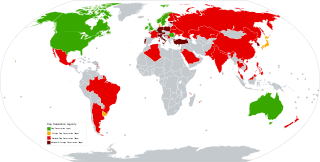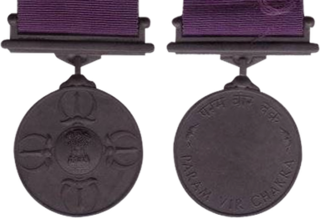
The State Emblem of India is the national emblem of the Republic of India and is used by the union government, many state governments, and other government agencies. The emblem is an adaptation of the Lion Capital of Ashoka, an ancient sculpture dating back to 280 BCE during the Maurya Empire. The statue is a three dimensional emblem showing four lions. It became the emblem of the Dominion of India in December 1947, and later the emblem of the Republic of India. The State Emblem of India is an official seal of the Government of India. It is used as the national emblem of India and appears on official documents, currency and passports.
An ex post facto law is a law that retroactively changes the legal consequences of actions that were committed, or relationships that existed, before the enactment of the law. In criminal law, it may criminalize actions that were legal when committed; it may aggravate a crime by bringing it into a more severe category than it was in when it was committed; it may change the punishment prescribed for a crime, as by adding new penalties or extending sentences; it may extend the statute of limitations; or it may alter the rules of evidence in order to make conviction for a crime likelier than it would have been when the deed was committed.

Flag desecration is the desecration of a flag, violation of flag protocol, or various acts that intentionally destroy, damage, or mutilate a flag in public. In the case of a national flag, such action is often intended to make a political point against a country or its policies. Some countries have laws against methods of destruction or forbidding particular uses ; such laws may distinguish between the desecration of the country's own national flag and the desecration of flags of other countries. Some countries have also banned the desecration of all types of flags from inside the country to other country flags.

The Param Vir Chakra (PVC) is India's highest military decoration, awarded for displaying distinguished acts of valour during wartime. Param Vir Chakra translates as the "Supreme Wheel of Bravery", and the award is granted for "most conspicuous bravery in the presence of the enemy". As of January 2018, the medal has been awarded 21 times, of which 14 were posthumous and 16 arose from actions in Indo-Pakistani conflicts. Of the 21 awardees, 20 have been from the Indian Army and one has been from the Indian Air Force. Major Somnath Sharma was the first recipient. A number of state governments of India as well as ministries of the central government provide allowances and rewards to recipients of the PVC.

The national flag of India, colloquially called Tiraṅgā, is a horizontal rectangular tricolour flag, the colours being of India saffron, white and India green; with the Ashoka Chakra, a 24-spoke wheel, in navy blue at its centre. It was adopted in its present form during a meeting of the Constituent Assembly held on 22 July 1947, and it became the official flag of the Union of India on 15 August 1947. The flag was subsequently retained as that of the Republic of India. In India, the term "tricolour" almost always refers to the Indian national flag.

The pillars of Ashoka are a series of monolithic pillars dispersed throughout the Indian subcontinent, erected—or at least inscribed with edicts—by the 3rd Mauryan Emperor Ashoka the Great, who reigned from c. 268 to 232 BC. Ashoka used the expression Dhaṃma thaṃbhā, i.e. "pillars of the Dharma" to describe his own pillars. These pillars constitute important monuments of the architecture of India, most of them exhibiting the characteristic Mauryan polish. Twenty of the pillars erected by Ashoka still survive, including those with inscriptions of his edicts. Only a few with animal capitals survive of which seven complete specimens are known. Two pillars were relocated by Firuz Shah Tughlaq to Delhi. Several pillars were relocated later by Mughal Empire rulers, the animal capitals being removed. Averaging between 12 and 15 m in height, and weighing up to 50 tons each, the pillars were dragged, sometimes hundreds of miles, to where they were erected.
Freedom of religion in India is a fundamental right guaranteed by Article 25-28 of the Constitution of India. Modern India came into existence in 1947 and the Indian constitution's preamble was amended in 1976 to state that India is a secular state. Supreme Court of India ruled that India was already a secular state from the time it adopted its constitution, what actually was done through this amendment is to state explicitly what was earlier contained implicitly under article 25 to 28. Every citizen of India has a right to practice and promote their religion peacefully. However, there have been numerous incidents of religious intolerance that resulted in riots and violence, notably, the 1984 Anti-Sikh Massacre in Delhi, 1990 Exodus of Kashmiri Pandits Brahmins from Kashmir, 1992-93 Bombay Riots in Mumbai, the 2008 Anti-Christian riots in Odisha. Some perpetrators of the 1984 Anti-Sikh Massacre in Delhi have not been brought to justice despite widespread condemnation.

The Kirti Chakra is an Indian military decoration awarded for valour, courageous action or self-sacrifice away from the field of battle. It may be awarded to civilians as well as military personnel, including posthumous awards. It is the peacetime equivalent of the Maha Vir Chakra. It is second in order of precedence of peacetime gallantry awards, comes after Ashoka Chakra and before Shaurya Chakra. Before 1967, the award was known as the Ashoka Chakra, Class II.

The dharmachakra or wheel of dharma is a symbol used in the Dharmic religions of Buddhism. It has a widespread use in Buddhism. In Hinduism, the symbol is particularly used in places that underwent religious transformation. The symbol also finds its usage in modern India.

The Prevention of Insults to National Honour Act, 1971 is an Act of the Parliament of India which prohibits the desecration of or insult to the country's national symbols, including the national flag, national emblem, national anthem, national motto, the constitution, and the map of India.

The Prevention of Corruption Act, 1988 is an Act of the Parliament of India enacted to combat corruption in government agencies and public sector businesses in India.

The Code of Criminal Procedure, commonly called Criminal Procedure Code (CrPC), was the main legislation on procedure for administration of substantive criminal law in India. It was enacted in 1973 and came into force on 1 April 1974. It provides the machinery for the investigation of crime, apprehension of suspected criminals, collection of evidence, determination of guilt or innocence of the accused person and the determination of punishment of the guilty. It also deals with public nuisance, prevention of offences and maintenance of wife, child and parents.

The Competition Act, 2002 was enacted by the Parliament of India and governs Indian competition law. It replaced the archaic Monopolies and Restrictive Trade Practices Act, 1969. Under this legislation, the Competition Commission of India was established to prevent the activities that adversely affected competition in India. This act extends to whole of India.
The Biological Diversity Act, 2002 is an Act by the Parliament of India for the preservation of biological diversity in India, and provides the mechanism for equitable sharing of benefits arising out of the use of traditional biological resources and knowledge. The Act was enacted to meet the obligations under the Convention on Biological Diversity, because India is a signatory to the treaty.

The Cigarettes and Other Tobacco Products Act, 2003 or COTPA, 2003 is an Act of Parliament of India enacted in 2003 to prohibit advertisement of, and regulate the trade and commerce in, the production, supply and distribution of cigarettes and other tobacco products in India.

The Prohibition of Child Marriage Act 2006 came into force on 1 November 2007 in India. It forbids child marriages, and protects and provides assistance to the victims of child marriages.
The Real Estate Act, 2016 is an Act of the Parliament of India which seeks to protect home-buyers as well as help boost investments in the real estate industry. The Act establishes a Real Estate Regulatory Authority (RERA) in each state for regulation of the real estate sector and also acts as an adjudicating body for speedy dispute resolution. The bill was passed by the Rajya Sabha on 10 March 2016 and by the Lok Sabha on 15 March 2016. The Act came into force on 1 May 2016 with 61 of 92 sections notified. The remaining provisions came into force on 1 May 2017. The Central and state governments are liable to notify the Rules under the Act within a statutory period of six months.

The Forest (Conservation) Act, 1980 an Act of the Parliament of India to provide for the conservation of forests and for matters connected therewith or ancillary or incidental thereto. It was further amended in 1988. This law extends to the whole of India. It was enacted by Parliament of India to control further deforestation of Forest Areas in India. The act came into force on 25 October 1980. It has five sections.
The Railways Act, 1989 is an Act of the Parliament of India which regulates all aspects of rail transport. The Act came into force in 1989, replacing the Railways Act of 1890. The Act provides in detail the legislative provisions regarding railway zones, construction and maintenance of works, passenger and employee services.
The Companies (Amendment) Act, 2015, of India, was granted the assent of the President on May 25, 2015, but was published in the Official Gazette on May 26, 2015. This Amendment aims to swiftly bridge some of the most pressing concerns of stakeholders such as the need to align business exigencies with certain actions deemed punishable with criminal law under the original Act of 1956 but not yet amended in the new Companies Act of 2013.







